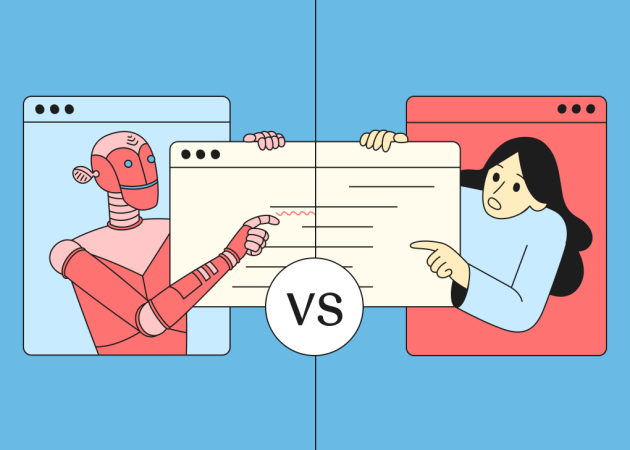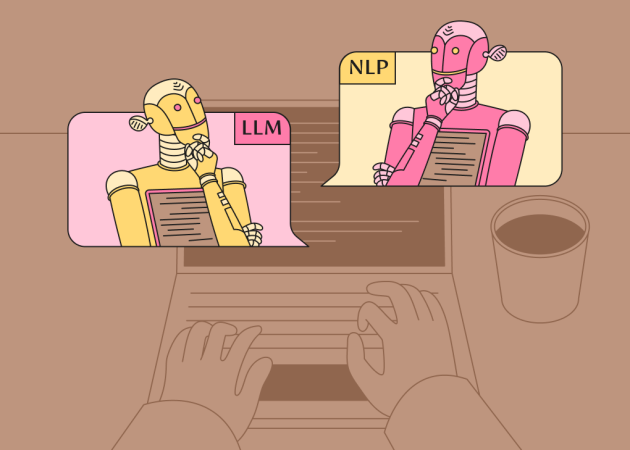
AI Agents vs Traditional Automation Tools: A Side-by-Side Look
Contents
Contents
Automation affected enterprise efficiency for a long time, with tools like RPA, scripts, and rule-based systems reducing manual effort. But as digital transformation becomes more rapid, the limits of these approaches create an issue. Business environments are increasingly dynamic, data rarely arrives in neat formats, and customer expectations demand faster, more personalized responses.
This is where AI agents enter the picture. Unlike traditional automation, they bring adaptability, contextual decision-making, and the ability to process unstructured data, qualities that open automation to entirely new classes of business problems.
In this article, we’ll break down how traditional automation and AI agents differ, where each excels, and how you can decide which approach or combination fits your strategic goals.
What Is Traditional Automation?
Traditional automation includes robotic process automation (RPA), scheduled scripts, and rule-based workflows. These solutions follow predefined instructions, making them reliable for invoice processing, payroll updates, report generation, transferring data between systems, and other similar tasks.
The RPA market alone generated US $3.8 billion in revenue in 2024, an 18% year-over-year increase, showing how widely enterprises still rely on this type of automation. They deliver process optimization by cutting manual work and minimizing human error, especially in high-volume, structured processes.
The drawback is that these systems are rigid. Small changes in formats or unexpected cases can break a workflow, and they can’t adjust when rules or customer needs evolve. Unstructured data is also a problem, which limits its value as you scale and processes get more complex. In reality, traditional automation is great for predictable, repetitive work, but it doesn’t have the adaptability or intelligence needed to keep up with digital transformation at scale.
What Are AI Agents?
AI agents are adaptive, context-aware systems powered by AI. They interpret inputs, learn from experience, and adjust their actions to meet changing conditions. This makes them effective for orchestrating decisions across multiple systems and handling unstructured data, from free-text emails to images or streaming sensor signals.
Benefits of AI agents include managing exceptions without constant oversight, integrating across diverse tools, and improving performance over time. This means moving beyond static task automation toward solutions that can scale with evolving processes and customer demands.
The trade-off is complexity: autonomous agents require more advanced data infrastructure, governance, and oversight to deploy responsibly. They’re most valuable if you need flexibility, contextual decision-making, and long-term adaptability, areas where traditional automation falls short.

AI Agents vs. Traditional Automation: Key Differences
While both AI and automation aim to reduce manual work, they approach the problem in different ways. Traditional tools thrive on consistency and predictability, while AI agents bring flexibility and intelligence to workflows that can’t be fully scripted. The choice often comes down to balancing stability with adaptability.
| Dimension | Traditional Automation (RPA, Scripts, Rule-Based) | AI Agents (Adaptive, Context-Aware Systems) |
| Decision-making style | Follows predefined rules, deterministic | Learns from data and makes context-based decisions |
| Adaptability | Rigid, breaks when conditions change | Flexible, adjusts to evolving scenarios |
| Data handling | Works with structured, standardized data | Processes unstructured data (text, images, voice, sensor inputs) |
| Task complexity | Best for repetitive, predictable workflows | Handles dynamic, multi-step, exception-heavy processes |
| Scalability | Scales linearly by adding more scripts/bots | Scales through continuous learning and system integration |
| Cost profile | Lower upfront, but higher maintenance as complexity grows | Higher upfront investment, potential for long-term efficiency and innovation |
| Risk | Limited risk if processes are stable, but brittle under change | Risks tied to data quality, governance, and explainability |
| Strategic fit | Suited for routine process optimization | Suited for digital transformation and evolving business models |
Traditional automation remains a strong option for stable and rule-based processes, while AI agents open the door to scalable, adaptive systems that align better with digital transformation goals. Many companies adopt a mix, using automation where consistency is key, and AI agents where adaptability creates strategic value.
Decision-Making: Rule-Based vs. Cognitive Approach
When it comes to traditional automation, it’s built on rule-based decision-making. In practice, it means if X happens, you do Y. The processes are predictable and easy to manage. Rigidity can be a setback, when conditions change. Common rule-based automation examples include validating structured forms such as invoices or expense claims, running scheduled payroll or compliance checks, or triggering alerts when fixed thresholds are met.
AI agents, by contrast, use cognitive decision-making. They draw on machine learning, inference, and context to choose actions rather than following fixed paths. This introduces a degree of uncertainty as outcomes may vary depending on data quality and context, but it also provides greater flexibility and adaptability. Cognitive automation is particularly useful for interpreting free-text customer inquiries, identifying anomalies in large and messy datasets, coordinating responses to multi-step, exception-heavy processes, etc.
The trade-off is between control and predictability with rule-based systems, and innovation and responsiveness with cognitive ones. The right choice depends on whether your business values stability in well-defined processes or agility in complex, evolving environments.
Data Handling: Structured vs. Unstructured Data
Traditional automation tools are built to work with structured data, such as spreadsheets, databases, and standardized forms, where the format is consistent and predictable. They perform well when inputs follow clear rules, but break down if information is incomplete, inconsistent, or arrives in unexpected formats.
Autonomous AI agents can process unstructured data such as emails, chat messages, images, PDFs, and even voice or sensor inputs. Customer service interactions, compliance documents, and IoT data streams all generate valuable insights that can’t be handled effectively by rule-based automation alone.
Structured data enables efficiency, while unstructured data unlocks adaptability and deeper insight. As enterprises digitize more of their operations, the ability to work with unstructured inputs becomes a competitive necessity.
Adaptability: Fixed Processes vs. Adaptive Learning
Fixed processes are at the core of traditional automation. When business rules, formats, or systems change, workflows often need manual updates from developers or IT teams. This creates ongoing maintenance overhead and slows down response to change. In stable environments, that rigidity can be acceptable, but it becomes a liability when processes evolve frequently.
AI agents can adjust based on feedback, spot patterns in new data, and refine their behavior over time without requiring constant reprogramming. This means lower maintenance costs, faster reaction to market shifts, and the ability to stay relevant as inputs, regulations, or customer expectations change.
When it comes to AI vs automation, fixed processes deliver predictability and adaptive systems offer resilience in dynamic environments. This adaptability lets you update processes in weeks and keep up with evolving regulations and customer needs.
Task Complexity: Simple, Repetitive vs. Complex, Multi-step
Simple and repetitive workflows work for traditional automation. Think of copying data between spreadsheets, generating monthly payroll files, or sending scheduled email reminders. These are tasks with clearly defined steps and little room for variation. Rule-based tools handle them quickly and reliably, but only as long as the process remains consistent.
AI agents can perform complex, multi-step tasks that involve planning, branching logic, and context. An AI agent can manage a customer service inquiry: reading an email, identifying the issue, pulling relevant records from multiple systems, and drafting a tailored response.
The main difference between AI agents vs traditional automation comes down to scope: traditional automation is best for routine tasks that never change, while AI agents extend automation into areas where exceptions, decision-making, and context matter.
When to Use AI Agents vs. Automation?
AI agents vs automation serve different purposes in your operations. The value comes from knowing which tool fits which type of task.
Traditional automation works well for stable, rules-driven tasks where consistency matters more than flexibility. For example, you might use it to:
- Process invoices and expense claims that follow a set format.
- Run payroll calculations on a fixed schedule.
- Transfer data between internal systems or generate routine reports.
- Schedule recurring system updates or backups.
- Move data from web forms into back-end systems without variation.
- Trigger alerts or notifications based on fixed thresholds (e.g., low inventory levels).
AI agents add value when your workflows involve unstructured inputs, branching steps, or frequent exceptions. In practice, this could mean:
- Managing customer support requests that arrive as free-text emails, chat messages, or calls.
- Reviewing compliance and governance documents to flag risks or anomalies.
- Orchestrating multi-step processes such as employee onboarding, supplier management, or resolving service disruptions.
- Personalizing marketing campaigns by analyzing customer interactions across different channels.
- Assisting in IT operations by diagnosing issues, recommending fixes, and escalating only when necessary.
- Coordinating supply chain adjustments based on demand signals, shipping delays, or external events.
The takeaway is simple: use traditional automation where rules are clear and tasks don’t change, and turn to AI-powered agents when workflows demand flexibility, contextual understanding, or multi-step decision-making. By mapping tasks to the right approach, you avoid overengineering simple processes and underestimating complex ones.

Hybrid Approach: Can AI and Automation Work Together?
You don’t have to treat traditional automation and AI agents as competing solutions. In practice, they’re most powerful when used together. Traditional automation is well-suited for high-volume, rules-based tasks, like invoice processing, payroll calculations, or data transfers between systems. These jobs don’t require intelligence, only consistency, and rule-based tools handle them with speed and reliability.
AI-powered agents come into play when processes are variable, adaptive, or context-heavy. AI agents can handle unstructured inputs like emails or scanned documents, step in when exceptions come up, and connect work across different systems without constant human oversight. That makes them especially useful in areas such as customer support, compliance checks, supply chain management, or any process that shifts quickly.
By combining both, you avoid overloading AI agents with repetitive work that doesn’t benefit from advanced intelligence, while also preventing traditional automation from becoming brittle in the face of change. The result is an automation strategy that balances efficiency and resilience: rule-based tools provide a stable backbone, while AI agents extend automation into areas that demand adaptability and insight.
Businesses that take this layered approach often find it easier to scale automation without hitting roadblocks. Routine processes run reliably in the background, while more complex workflows stay agile and aligned with evolving business needs. Instead of replacement, the two approaches reinforce one another, helping you build a more flexible and future-ready operations model.
Choosing the Right Approach for Your Business
The decision between traditional automation and AI agents isn’t about picking one over the other; it’s about aligning the tool with the task. Rule-based automation is best for simple, structured, and repetitive workflows, while AI agents add value when you’re dealing with unstructured data, complex decision-making, or rapidly changing conditions. The right mix depends on your organization’s task complexity, data landscape, and broader digital transformation goals.
At Beetroot, we help you to design a balanced, future-proof automation strategy. By combining stable process automation with adaptive AI capabilities, we enable you to reduce manual effort today while staying agile for the challenges of tomorrow.
FAQs
Can AI agents handle unstructured data like emails and PDFs?
Yes. Unlike traditional automation, which works best with structured formats such as spreadsheets and databases, AI agents can interpret unstructured inputs, including emails, PDFs, images, and chat messages. With this capability, they can handle customer inquiries, review compliance documents, and pull insights from different data sources without the need for heavy upfront formatting.
How much does it cost to implement AI agents compared to traditional automation?
Traditional automation often costs less to set up, but it needs regular updates and ongoing maintenance whenever processes change. AI agents need more resources for infrastructure, data pipelines, and governance. However, they offer longer-term value by adapting to new inputs without constant reprogramming, reducing the total cost of ownership over time.
Do AI agents require human supervision?
They can run autonomously for many tasks, but oversight remains important. Humans are needed to set policies, review high-impact decisions, and intervene in exceptional cases. This ensures that AI agents operate within compliance boundaries while still delivering efficiency and responsiveness.
What industries can benefit most from AI agents?
AI agents are especially useful in industries that deal with a lot of complex data. AI agents support fraud detection and customer service in finance, analyze clinical documents and patient records in healthcare, and stabilize supply chains in logistics when conditions change. They also help retail, telecom, and professional services manage unstructured information and respond to shifting customer demands.
Are AI agents replacing traditional automation or complementing it?
They complement rather than replace traditional automation. Rule-based systems are still the best fit for highly structured, repetitive processes. AI agents extend automation into adaptive, context-driven areas, and together, they provide a balanced approach that combines stability with flexibility.
How secure are AI agents when handling sensitive business data?
The right setup determines matters of security. With the right safeguards, like encryption, access controls, and audit logs, they can safely handle sensitive information. It’s also important to align deployments with regulations such as GDPR, HIPAA, or other industry standards to keep risks under control.
What’s the difference between AI agents, intelligent automation, and RPA?
RPA uses software bots to carry out rule-based tasks one step at a time, which makes it well-suited for structured, repetitive work. Intelligent automation takes this further by adding AI capabilities like natural language processing or optical character recognition, allowing it to handle semi-structured tasks too. AI agents go further still: they are adaptive, context-aware systems that can learn from data, make decisions in real time, and manage dynamic, multi-step workflows across different systems.
Subscribe to blog updates
Get the best new articles in your inbox. Get the lastest content first.
Recent articles from our magazine
Contact Us
Find out how we can help extend your tech team for sustainable growth.







